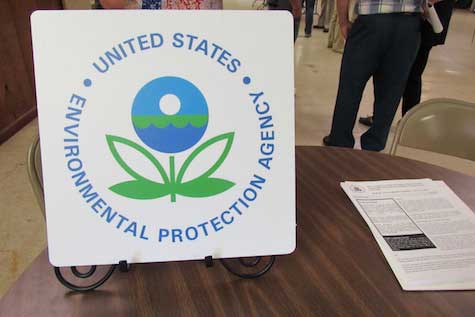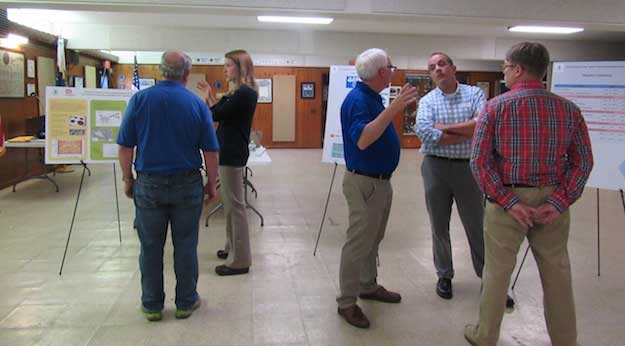Next phase of Diaz remediation in Holley includes soil, groundwater
Purchase offers submitted for 6 of 8 ‘Diaz homes’
HOLLEY – The federal Environmental Protection Agency is moving forward with the next stage of cleanup from the former Diaz Chemical Corp.
The EPA also announced on Tuesday it has received offers on eight houses that were left vacant because residents were worried the sites were contaminated by Diaz.
John DiMartino, Remedial Project Manager for the EPA, told Holley Village Board members Tuesday evening that the Village of Holley Development Corporation (VHDC) has received six offers on the eight former Diaz homes, and that the change in deeds to the VHDC was recorded June 29.
“The offers were reasonable, we will not be a roadblock,” he told the board. “This is great news.”
He credited VHDC President Daniel Schiavone for “working very hard” to make the change in ownership of the abandoned homes to the VHDC – and ultimately their return to the tax rolls – possible.
He said the transfer of the properties to the VHDC, “has been a learning process for us… from time to time (the EPA) acquires property, we rarely buy homes and become landlords.”
DiMartino reviewed the agreement between the VHDC, the village, and the EPA to transfer the deeds of the eight properties located near the former Diaz Chemical site on Jackson Street. Buyers will have to provide documentation in the form of a receipt from a lead abatement contractor, that lead abatement is complete on the homes before a certificate of occupancy is issued.
The EPA provided the VHDC with a packet of information for each home – including appraisals and results of testing done by the EPA.
DiMartino said testing showed that no chemicals related to the Diaz release in 2002 were found in any of the eight homes.
“We spent time and money to try and link these items to Diaz,” DiMartino said of testing, but anything found was typical of what would be found in any home in a rural setting.

EPA officials and contractors were at the American Legion in Holley on Tuesday to answer questions of residents regarding soil and groundwater cleanup at the Diaz Chemical Superfund site.
DiMartino was in Holley Tuesday for a public availability session from 5 to 7 p.m. at the American Legion on Wright Street, regarding the next phase of cleanup at the Diaz Chemical Superfund Site.
The session was sparsely attended, but DiMartino told village leaders the site will now become a busy place as preparation for Phase I of in-situ thermal treatment (ISTT) of soil and groundwater gets underway.
“It’s going well,” DiMartino said of the process of site work. He called the Diaz chemicals that remain in the ground, “unusual and odd-ball…. we need to see how they react (to the thermal process).”
That means Phase I will cover only 10 percent of the overall site.
“It’s pretty aggressive technology,” he explained. “There is tight geology there, you can’t just pump it out.”
Phase I is expected to take about one year. Construction of the thermal treatment system will begin this summer with treatment operations beginning in December.
DiMartino said the ground will be heated to two different temps, “and we will see how the Diaz chemicals respond.”
Phase I is completely funded, he said. Phase II will not begin until after results from Phase I are known. The EPA will then have to design how Phase II will be carried out and complete the process of contracting and funding again.
He estimated the cost of Phase II work to be $30 million – a “ballpark figure.” Because of the cost, he said the EPA envisions “rolling funding” over the work of Phase II. Completing the process of cleaning-up contaminated soils could take several years, DiMartino indicated.
He described the thermal extraction process, which dries the chemicals out. They are then collected in vapor form, distilled, treated and then vented into the atmosphere.
“It is safe for residents,” DiMartino said.
Air monitoring will be done around the perimeter of the site during the process.
“Thermal has been done in many other sites,” he said. “It is a proven technology.”
DiMartino noted above ground cleanup is complete – buildings, drums and pipes with chemicals have been removed and the next phase of cleanup will focus on soil and groundwater. He said the groundwater plume for the site is not very long.
“We don’t anticipate volatilization into groundwater,” he said.
He also told village leaders the Diaz site will be kept mowed.
During the public availability session earlier in the evening, residents questioned how the use of electricity in the thermal process would affect their rates for Village of Holley Municipal Electric. DiMartino told Village Board members National Grid can provide power for the process.






































































